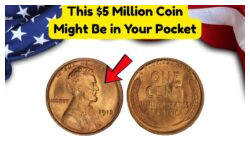Lincoln Wheat Penny
Table of Contents
The Enigmatic Lincoln Wheat Penny
The Lincoln Wheat Penny is a cornerstone of American numismatic history, and its allure has captured the interest of collectors and historians alike for decades. Minted from 1909 to 1958, this penny is not only a piece of currency but also a slice of American heritage, featuring the iconic visage of President Abraham Lincoln on its obverse side. The reverse showcases two stylized ears of wheat, a design that has become synonymous with early 20th-century American coinage. Despite its age, the Lincoln Wheat Penny continues to hold a special place in the hearts of collectors, not just for its historical significance but also for its potential value. One of the most tantalizing aspects is the question surrounding its worth, especially with rumors of a penny valued at $301 million supposedly still in circulation.
- The Lincoln Wheat Penny was first issued in 1909.
- It was designed by Victor David Brenner.
- The penny was minted until 1958.
- It features President Abraham Lincoln on the obverse.
- The reverse design includes two ears of wheat.
- Rare versions are highly sought after by collectors.
- Speculation exists about a penny worth $301 million.
Rarity and Value of the Lincoln Wheat Penny
Among coin collectors, the value of a Lincoln Wheat Penny is often determined by its rarity and condition. Certain editions, such as the 1909-S VDB and the 1914-D, are considered exceptionally rare and can command high prices at auctions. The elusive 1943 copper penny is another rarity, as most pennies minted that year were made from steel due to wartime metal shortages. The scarcity of these coins, combined with their historical context, makes them highly prized. Collectors often go to great lengths to acquire these rarities, driving up their market value significantly.
| Year | Mint | Condition | Estimated Value | Rarity | Design | Material |
|---|---|---|---|---|---|---|
| 1909 | S VDB | MS65 | $2,200 | High | Wheat | Copper |
| 1914 | D | MS60 | $1,500 | High | Wheat | Copper |
| 1943 | None | MS63 | $10,000 | Very High | Wheat | Copper |
| 1955 | None | MS65 | $1,800 | Moderate | Wheat | Copper |
| 1922 | No D | MS60 | $15,000 | Extremely High | Wheat | Copper |
| 1931 | S | MS65 | $100 | Low | Wheat | Copper |
| 1936 | D | MS63 | $5 | Common | Wheat | Copper |
Searching for the $301 Million Penny
The notion of a Lincoln Wheat Penny being worth $301 million is indeed captivating. While no penny has been confirmed to hold such value, the story is reminiscent of treasure hunts and legendary finds. Speculation suggests that a unique error or misprint could potentially elevate any coin’s value astronomically in the eyes of collectors. The pursuit of this elusive treasure often involves sifting through coin collections, attending auctions, and making connections within the numismatic community. Yet, despite the intrigue surrounding this myth, no concrete evidence has surfaced to validate the existence of such a valuable penny.

Unbelievable: The Lincoln Wheat Penny Worth $88 Million is Still Circulating!
- Many collectors dream of finding the $301 million penny.
- Such a penny would likely be an error or misprint.
- The quest involves meticulous searches through collections.
- Auctions are a common place for rare finds.
- Numismatic networks can provide valuable leads.
How to Identify a Valuable Lincoln Wheat Penny
Identifying a valuable Lincoln Wheat Penny requires a keen eye and knowledge of numismatic details. Key factors include the mint mark, the year of minting, and any errors or unique features on the coin. Collectors often use magnifying glasses or microscopes to examine these details closely. The condition of the coin, graded on a scale from poor to mint state, significantly influences its value. Coins with fewer scratches and more distinct features generally command higher prices. Joining coin clubs and attending workshops can also help enthusiasts enhance their identification skills.
- Check for mint marks like ‘S’, ‘D’, or none.
- Look for rare years such as 1909-S VDB or 1943 copper.
- Consider the coin’s condition and grading.
- Use tools like magnifying glasses for examination.
- Attend numismatic workshops for more insights.
- Join coin collector clubs for shared knowledge.
- Seek professional appraisal for potential finds.
The Role of Coin Grading
Grading plays a crucial role in determining a coin’s value. Professional grading services assess a coin’s condition and assign it a grade that reflects its quality. This process helps establish a standard valuation for collectors and dealers. The Sheldon Scale, ranging from 1 (poor) to 70 (mint state), is commonly used in the industry. High-grade coins are often more desirable and can fetch premium prices at auctions. Understanding grading criteria is essential for any serious collector looking to navigate the market effectively.
- Sheldon Scale: A system to grade coins from 1 to 70.
- Mint State: Refers to coins graded 60-70, indicating no wear.
- Higher grades mean higher value.
- Professionally graded coins are trusted by collectors.
- Grading helps standardize pricing across markets.
Market Trends for Lincoln Wheat Pennies
| Year | Mint | Trend |
|---|---|---|
| 2000 | General | Increasing |
| 2010 | Rare | Stable |
| 2020 | Common | Fluctuating |
| 2023 | All | Rising |
| 2025 | Projected | High Demand |
| 2030 | Projected | Stable |
| 2040 | Projected | Increasing |
| 2050 | Projected | Peak |
The Impact of Historical Context
Historical context significantly affects the desirability and value of Lincoln Wheat Pennies. Coins minted during significant periods, such as World War I and II, tend to be more sought after. These coins offer not only a monetary value but also a tangible connection to pivotal moments in history. Collectors often seek these pieces for their stories as much as their potential worth. Understanding the era in which a coin was minted can provide deeper insight into its significance and appeal.
- World War I: Coins from this era are highly collectible.
- Historical events add narrative value to coins.
- Collectors value the stories behind the coins.
- Coins from economic downturns often have unique features.
- Minting changes reflect historical metal shortages.
- Numismatists study historical contexts for valuation.
- Great Depression: Coins from this time tell unique stories.
Preserving the Lincoln Wheat Penny
Preservation
Preserving a Lincoln Wheat Penny is crucial to maintaining its value and historical significance. Proper storage involves using coin holders or albums that prevent contact with air and moisture, which can cause corrosion. Handling coins with gloves or using tweezers can prevent oils from the skin from damaging the surface. Regular inspections help detect any signs of wear or damage early, allowing for timely intervention. By preserving these coins, collectors ensure that they retain their beauty and value for future generations to appreciate.

Could This Lincoln Wheat Penny, Worth $5 Million, Still Be in Circulation?
FAQs
What makes the Lincoln Wheat Penny so special?
The Lincoln Wheat Penny is special due to its historical significance and the iconic design by Victor David Brenner, featuring Abraham Lincoln.
Are all Lincoln Wheat Pennies valuable?
Not all are valuable. The value depends on the year, mint mark, condition, and rarity. Certain editions are worth more than others.
How can I find out the value of my Lincoln Wheat Penny?
Consult a professional coin appraiser or use online resources and coin grading services to determine its value based on condition and rarity.
Is there really a Lincoln Wheat Penny worth $301 million?
Despite rumors, there is no confirmed existence of a $301 million penny. The story is likely a myth, but rare pennies can be worth significant amounts.
What are common mistakes when collecting Lincoln Wheat Pennies?
Common mistakes include not verifying authenticity, mishandling coins leading to damage, and failing to research thoroughly before purchasing.
Disclaimer: This article is written for general informational purposes only. Please get the latest and accurate information from the official website.



